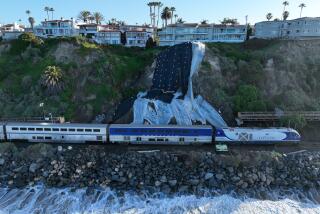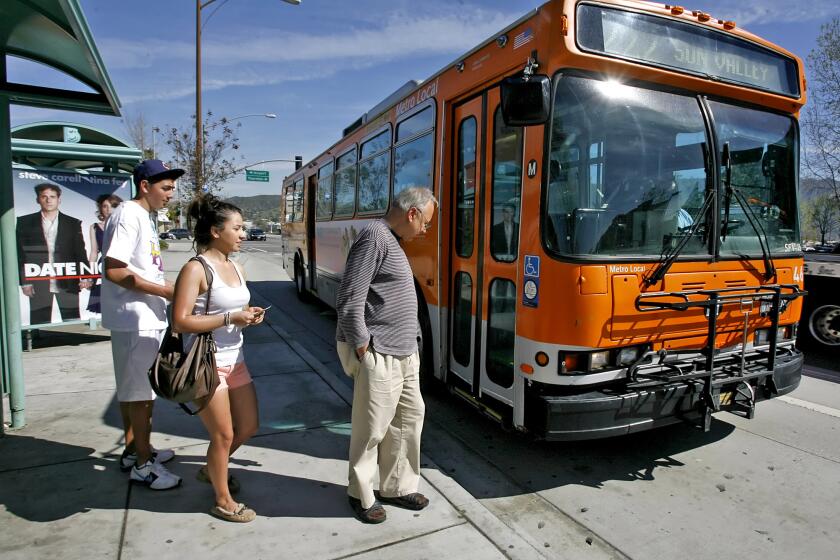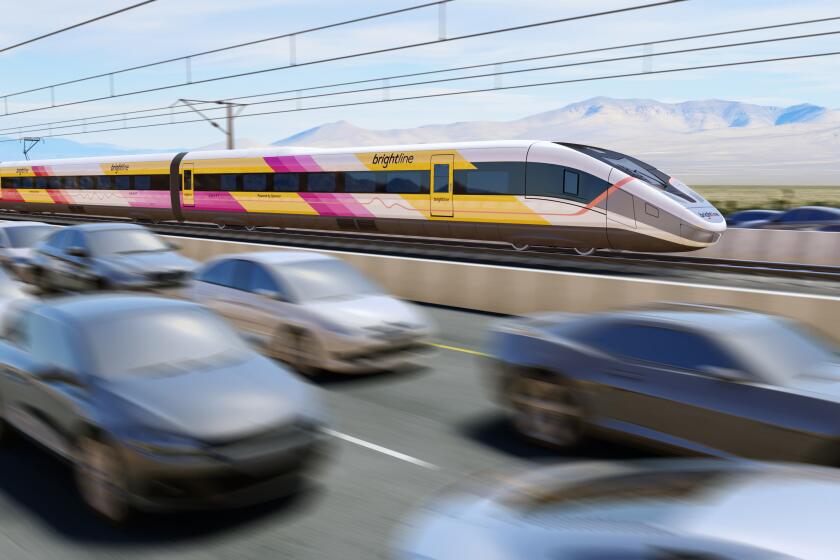Noxious Fumes Halt Metro Rail Subway Work
Construction along the entire 4.4-mile Metro Rail system in downtown Los Angeles was shut down by state safety inspectors Thursday, and hundreds of workers were ordered outside when poor ventilation failed to clear the incomplete tunnel of noxious fumes, officials said.
Diesel machinery being used in finishing work in the underground tunnels fouled the air and forced inspectors to halt work until a better ventilation system can be installed, according to spokesmen for Cal/OSHA and other agencies involved in the subway.
Work could resume as early as today, contractors said.
It was the latest safety problem to hit the trouble-plagued Metro Rail system, a $3.9-billion project that is millions of dollars over budget and months behind schedule. A year ago, a devastating fire gutted a 750-foot segment of the tunnel near Union Station, further slowing down completion of the ambitious rail system.
A total of 390 people were working on Metro Rail on Thursday when it was closed. Those who were working underground were ordered out of the tunnel. No injuries were reported, and the level of air contamination was not considered life-threatening.
“We were putting up some scaffolding on the platform at the Alvarado station,” said laborer Louie Gutierrez, 31. “All of a sudden, the foreman came and said we’re shut down. They said there was not enough ventilation in the tunnel.
“They just sent everybody home,” Gutierrez said. “That’s rough because it means no pay.”
The problem was detected when Cal/OSHA received several complaints from employees decrying the quality of the air in the tunnel.
Inspectors took air samples Tuesday and again Thursday before issuing a stop-work order. Orange tags warning people to stay out of the twin tunnels, which stretch from the Los Angeles River to MacArthur Park, were placed at entryways along the route.
“The problem is the ventilation system,” Rick Rice, a spokesman for Cal/OSHA said. “The air was not being replaced fast enough with the system they were using in order to allow for the air to be breathable and healthy.
“It’s like being in a closed room where there is very little air circulation. When you get employees in there working and machines working, the quality of air diminishes in the course of the day.”
Managers of the Metro Rail project said they were taking immediate steps to correct the problem.
A detailed ventilation plan will be submitted to Cal/OSHA this morning that includes installing four additional fans on the job site, said Ed McSpedon, president of the Rail Construction Corp., which supervises Metro Rail for the Los Angeles County Transportation Commission.
Under the plan, two fans would be installed at the 7th and Alvarado station and two more at Union Station, McSpedon said. Also, he said, additional vents will be opened along the center portion of the tunnel to increase air flow.
If that does not meet Cal/OSHA standards, he said, a schedule would be devised so that the diesel machinery is not operated at times that the tunnel is full of workers, and some of the platform exhaust fans may be activated.
“We’re going to get enough ventilation in there to satisfy them,” McSpedon said.
“It’s not a hostile environment we’re dealing with here. . . . We’ve been running diesel trucks through there (the tunnels) and they’re emitting diesel fumes. Cal/OSHA . . . checked, and there were no problems (with the level of contaminants), but the air flow levels weren’t up to the standards.”
Depending on whether Cal/OSHA accepts the ventilation plan, McSpedon expected work to resume on Metro Rail later today or Monday.
McSpedon said that until Thursday, air was circulating inside the tunnel thanks to natural ventilation and several portable fans.
Two other ventilation systems--a huge set of fans designed for emergencies and an exhaust system installed at platforms--are in place but are not scheduled to be activated until the subway begins transporting passengers.
After completing an investigation, Cal/OSHA inspectors will decide whether to issue citations and levy fines in connection with the ventilation problem, Rice said. McSpedon said a citation would be appealed.
Most of the construction on the first phase of Metro Rail has been completed and finishing work is under way. This includes the laying of miles of electrical cable, placement of tiles and installation of signaling systems.
Last year’s fire, in which a portion of the tunnel collapsed underneath the Hollywood Freeway, exposed numerous safety problems in the Metro Rail project. Although state and city officials praised Metro Rail’s safety record, a survey by The Times revealed a worker injury rate that far exceeded the national average.
Later, fire officials determined the $2.2-million July 13 blaze was an accident, caused probably by a metal-cutting torch.
It was one of a series of accidents that have marred work on Metro Rail. Last September, a crane operator working near the tunnel that burned fell 20 feet down an air shaft, sustaining numerous injuries. Eleven months before that, two workers were injured when a cable snapped between a construction locomotive and a huge piece of digging equipment.
And during the rains of last March, leaks were discovered in the plastic lining designed to keep explosive methane and poisonous hydrogen sulfide gases out of the tunnels. Officials ordered $2.5 million in repairs.
Metro Rail, the city’s largest public works project in recent decades, is a 17-mile subway designed to link downtown Los Angeles to North Hollywood. The first 4.4-mile phase, which has been under construction since late 1987, is $135 million over budget and at least 18 months behind schedule.
It is currently slated for completion in September, 1993.
A Troubled Past
The 4.4-mile Metro Rail system in downtown Los Angeles was shut down Thursday by state safety inspectors and hundreds of workers were ordered outside because of ventilation problems in the incomplete subway. Here is a look at some previous problems:
May, 1991: Plastic liners designed to keep methane and poisonous hydrogen sulfide gases out of Metro Rail tunnels leak more water than expected during heavy rains, prompting $2.5 million in repairs.
September, 1990: A crane operator at a Metro Rail construction site is injured when he falls 20 feet down an air shaft near Union Station.
July, 1990: A metal-cutting torch sets off a fire, destroying a 750-foot stretch of tunnel near Union Station and costing $2.2 million.
April, 1990: Two underground workers are slightly injured when a concrete chute breaks and hits them at 5th and Hill streets.
October, 1989: Two Metro Rail workers are injured when cable snaps.
June, 1989: A worker suffers smoke inhalation in a fire at a Metro Rail construction site beneath 1st and Hill streets.
July, 1988: Six members of a DWP work team are injured while trying to reconnect a 4,800-volt line shut down for Metro Rail construction.
Compiled by Times researcher Cecilia Rasmussen
More to Read
Start your day right
Sign up for Essential California for news, features and recommendations from the L.A. Times and beyond in your inbox six days a week.
You may occasionally receive promotional content from the Los Angeles Times.







